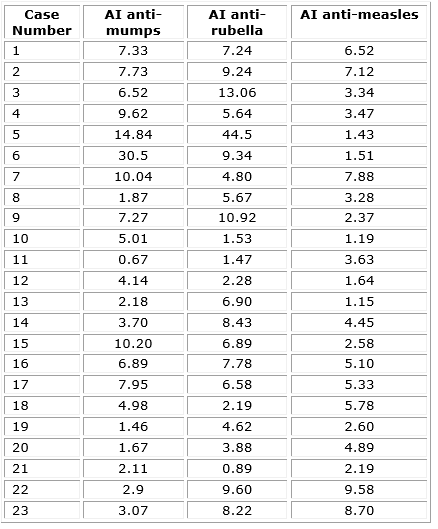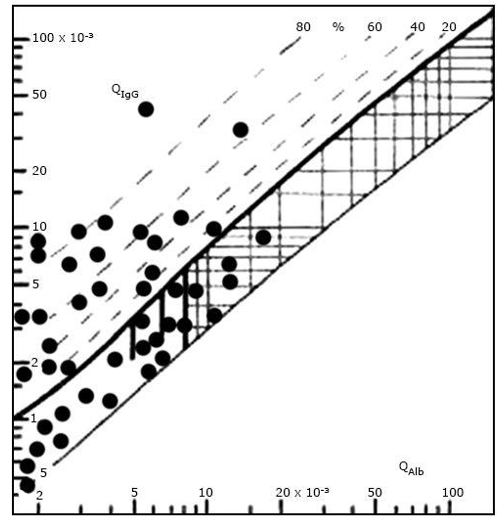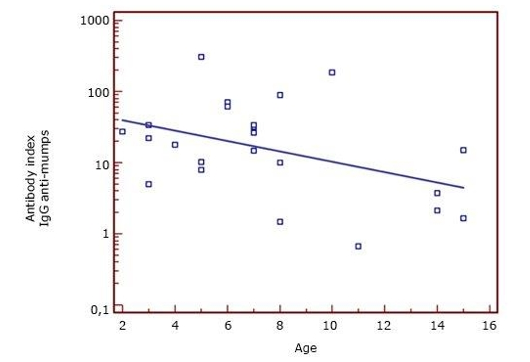Short comunication
Neuroimmunological approach for evaluation of viral measles, mumps and rubella (MMR) triple vaccine
Enfoque neuroinmunológico para la evaluación de la vacuna triple vírica contra el sarampión, la parotiditis y la rubéola
William Castillo González
1
, Mileydis Cruz Quevedo
2
, José Alejandro Rodríguez Pérez
1
, Eneida Barrios Lamoth
1
, Cristóbal González Losada
1
, Alberto Juan Dorta Contreras
1
*
1 Facultad de Ciencias Médicas “Miguel Enríquez”, Laboratorio Central de Líquido Cefalorraquídeo (LABCEL). La Habana, Cuba.
2 Universidad de Ciencias Médicas de La Habana, Instituto de Ciencias Básicas y Preclínicas “Victorias de Girón”. Cuba.
ABSTRACT
Introduction:
During the neuroinflammatory processes there are a poly-specific and polyclonal activation in the cerebrospinal fluid. It means that there can be quantified antibodies against all the components of the vaccines may have received.
Objective:
To evaluate the immune response against measles, mumps and rubella in vaccinated pediatric patients.
Methods:
All the serum and cerebrospinal fluid (CSF) paired samples from pediatric patients with neurological symptoms, that were submitted to hospitals from Havana City and were performed a lumbar puncture, were collected. Serum and CSF IgG, albumin were measured by immune-diffusion techniques using NOR and LC Partigen Immunoplates (Siemens, Marburg) and specific antibodies against measles, mumps and rubella were quantified by ELISA kits (Enzygnost, Siemens, Marburg). Reibergrams were employed in order to determine if there was IgG intrathecal synthesis. Later on, antibody index against the specific virus were calculated.
Results:
In all the neuroimmune inflammation process were found antibody index against measles, mumps and rubella in a different ample confidence variation among the different virus. Antibodies against mumps are significantly different from the other ones. It could be due to a natural different immune response or due to a deficient vaccine quality lot. Also it was possible to identify six pediatric patients that had no immune antibody index at all. It coincides with a transient hypogammaglobulinemia of infancy in such patients. Conclusions: This neuroimmunological approach can be used to evaluate the immune status in pediatric population.
Key words: neuroimmunology; triple vaccine; antibody index
RESUMEN
Introducción:
Durante los procesos neuroinflamatorios se produce una activación poliespecífica y policlonal en el líquido cefalorraquídeo. Eso significa que pueden existir anticuerpos cuantificados contra todos los componentes de las vacunas que se reciban.
Objetivo:
Evaluar la respuesta inmune contra el sarampión, las paperas y la rubéola en pacientes pediátricos vacunados.
Métodos:
Se recogieron muestras pareadas de suero y líquido cefalorraquídeo (LCR) de pacientes pediátricos con síntomas neurológicos mediante punciones lumbares realizadas en hospitales de Ciudad de La Habana. El IgG y la albúmina del suero y el LCR fueron medidos con técnicas de inmunodifusión usando inmunoplacas Partigen NOR y LC (Siemens, Marburgo). Los anticuerpos específicos contra el sarampión, la parotiditis y la rubéola se cuantificaron con dispositivos para ELISA (Enzygnost, Siemens, Marburgo). Se utilizaron reibergramas para determinar la presencia de síntesis intratecal de IgG. Seguidamente se calculó el índice de anticuerpos contra el virus específico.
Resultados:
En todos los procesos de inflamación neuroinmune se encontraron índices de anticuerpos contra el sarampión, la parotiditis y la rubéola con una variación amplia y diferente entre los distintos virus. Los anticuerpos contra la parotiditis son significativamente diferentes a los demás, lo que puede deberse a una respuesta inmune natural distinta o a una deficiente calidad de las vacunas. También fue posible identificar a seis pacientes pediátricos en los que no se observó ningún índice de anticuerpos inmunes, en coincidencia con la presencia de hipogammaglobulinemia transitoria infantil en esos pacientes.
Conclusiones:
El enfoque neuroinmunológico que se describe puede usarse para evaluar el estado inmunológico de la población pediátrica.
Palabras-clave: neuroinmunología; vacuna triple; índice de anticuerpos
INTRODUCTION
The meningoencephalitis is a group of diseases where occur an inflammatory reaction in the central nervous system and it depends of host and agent´s factors. The lumbar puncture is one of the most important tools for the diagnosis of the infectious disease of the central nervous system.1,2
The trivalent combined vaccines have been used during years in United States and in most of the European countries; also Argentina, Brazil, Chile, Colombia, Costa Rica, El Salvador, México, Panamá y Uruguay and Cuba the measles, mumps and rubella vaccine (MMR) are included in vaccine national program.3
The investigation problem is the determination of IgG anti- measles, mumps and rubella antibodies in pediatrics patients with meningoencephalitis, the relation between levels of serum and cerebrospinal fluid antibodies and antibody index anti- measles, mumps and rubella with age and vaccine year.
METHODS
All the serum and cerebrospinal fluid (CSF) paired samples from pediatric patients with neurological symptoms, that were submitted to hospitals from Havana City and were performed a lumbar puncture, were collected. 46 patients with meningoencephalitis were studied. The albumin and IgG serum were quantified in badges of radial immunodiffusion NOR Partigen (Siemens, Marburg), and the concentrations of these molecules in the LCR were determined using badges LC Partigen. The levels of antibodies anti-measles, mumps and rubella were determined by ELISA (Siemens, Marburg). The patients who presented intrathecal synthesis of IgG was calculated the antibody index (AI) against the three viruses (Fig. 1).
RESULTS
A high prevalence of intrathecal synthesis of IgG in the pediatric patients with viral meningoencephalitis was found, indicative of an inflammatory process in the central nervous system with not dysfunction of the barrier serum/CSF, a distinctive characteristic4 (table).
Table. Antibody index of 23 cases with intratecal synthesis

In all the neuroimmune inflammation processes were found antibody index against measles, mumps and rubella in an ample different confidence variation among the different virus. Antibodies against mumps are significantly different from the other ones. It could be due to a natural different immune response or due to a deficient vaccine quality lot. Furthermore, it was possible to identify six pediatric patients that had no immune antibody index at all. It coincides with a transient immunodeficiency of infancy in such patients5.
Is verified a polyspecific synthesis to the three viruses according to the antibody index, suggesting synthesis of IgG specific antibody in the central nervous system.6 The levels of anti-measles antibody in CSF and serum are correlated positively, indicative of the flow of them to the CSF proportionally and in a lineal way.
A significant correlation was evidenced among the AI anti-mumps in relation to the age and at the time of answer, determined by factors like the vaccination age, the use of a single dose and deficient vaccine quality lot (Fig. 2).7 Significant correlation did not exist between the AI anti-rubella and anti-measles with the age, time of answer and year of vaccination, evidencing a cellular and humoral immune answer.8
DISCUSSION
In all the neuroimmune inflammation processes were found antibody index against measles, mumps and rubella in an ample different confidence variation among the different virus. Antibodies against mumps are significantly different from the other ones. It could be due to a natural different immune response or due to a deficient vaccine quality lot. Furthermore, it was possible to identify six pediatric patients that had no immune antibody index at all. It coincides with a transient immunodeficiency of infancy in such patients.5
Is verified a polyspecific synthesis to the three viruses according to the antibody index, suggesting synthesis of IgG specific antibody in the central nervous system.6) The levels of anti-measles antibody in CSF and serum are correlated positively, indicative of the flow of them to the CSF proportionally and in a lineal way.
CONCLUSION
This neuroimmunological approach can be used to evaluate the immune status in pediatric population.
REFERENCES
1.
Reiber H. Cerebrospinal fluid data compilation and knowledge-based interpretation of bacterial, viral, parasitic, oncological, chronic inflammatory and demyelinating diseases. Diagnostic patterns not to be missed in neurology and psychiatry. Arquivos de Neuro-Psiquiatria. 2016 [acceso 15/03/2019];74:337-50. Disponible en: https://www.ncbi.nlm.nih.gov/pubmed/273320771.
[ Links ]
2.
Kliegman RM, Berhman RE, Jenson Hal B, Stanton Bonita F. Tratado de Pediatría. 19a ed. Barcelona: Elseiver. 2013 [acceso 15/03/2019]. Disponible en: https://www.worldcat.org/title/nelson-tratado-de-pediatria/oclc/857899476?referer=di&ht=edition2.
[ Links ]
3.
Black J. Microbiology. Principles and Explorations. Boston: John Wiley & Sons, Inc.; 2014. [ Links ]
4.
Dorta A. Pattern of intrathecal immunoglobulin synthesis in pediatric patients with infectious meningoencephalitis. Biotecnología Aplicada. 2006 [acceso 15/03/2019];23(4):383-7. Disponible en: https://www.researchgate.net/publication/304675142_Pattern_of_intrathecal_immunoglobulin_synthesis_in_pediatric_patients_with_infectious_meningoencephalitis4.
[ Links ]
5.
Eroglu F, Aerts Kaya F, Cagdas D, Yilmaz T. B lymphocyte subsets and outcomes in patients with an initial diagnosis of transient hypogammaglobulinemia of infancy. Scand J Immunol. 2018;88(4):e12709. doi: 10.1111/sji.12709. PubMed PMID: 30152873. [ Links ]
6.
Robinson Agramonte M, Hansotto R, Cabrera Gomez J, Galvizu R. Intrathecal polyspecific immune response to neurotropic viruses in multiple esclerosis: a comparative report from Cuban patients. Acta Neurol Scand. 2007 [acceso 15/03/2019];115:312-8. Disponible en: https://doi.org/10.1111/j.1600-0404.2006.00755.x6.
[ Links ]
7.
Castillo González W, González Losada C, Iglesias González IM, Dorta Contreras AJ. Pesquisa inmuno-epidemiológica en niños con meningoencefalitis vírica vacunados contra la parotiditis, rubeola y sarampión. Vaccimonitor. 2019 [acceso 29/03/2019];28:19-28. Disponible en: http://scielo.sld.cu/scielo.php?script=sci_arttext&pid=S1025-028X2019000100019&nrm=iso7.
[ Links ]
8.
Abbas A, Litchman A, Pillai S. Cellular and Molecular Immunology. 8th ed: Elsevier. 2014 [acceso 04/04/2019]:544. Disponible: http://www.elsevier.com/books/cellular-and-molecular-immunology/abbas/978-0-323-22275-48.
[ Links ]

















